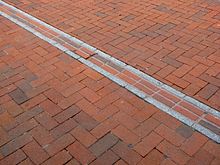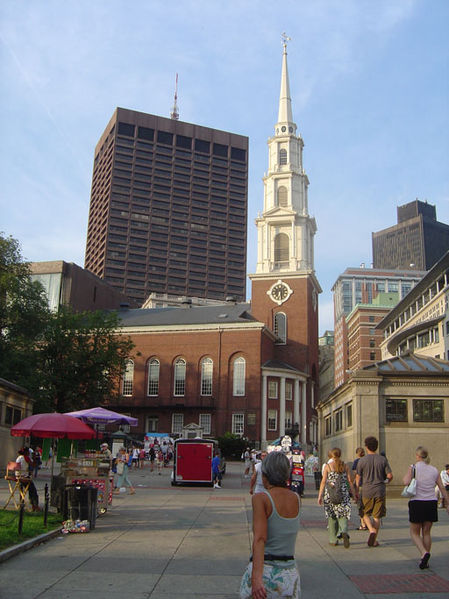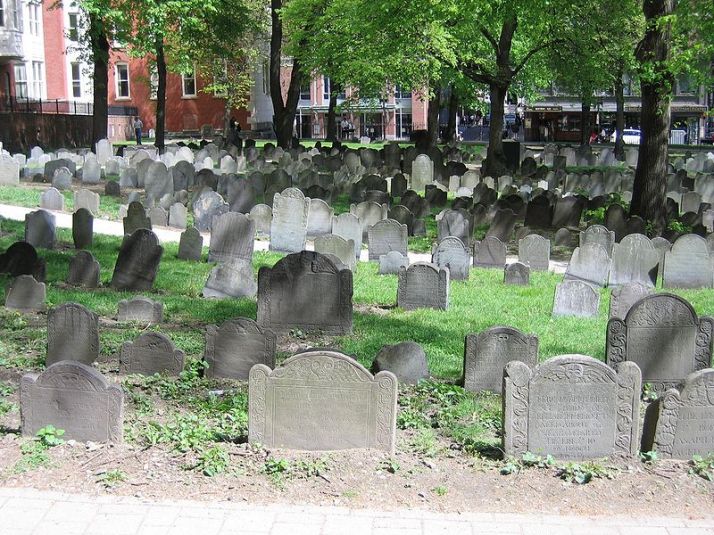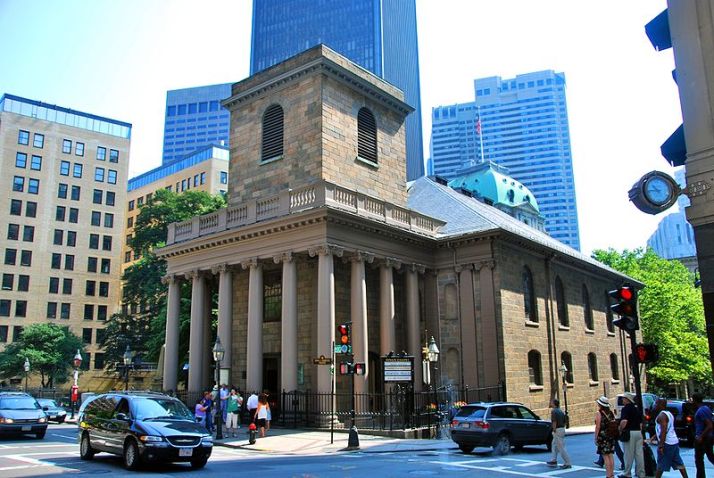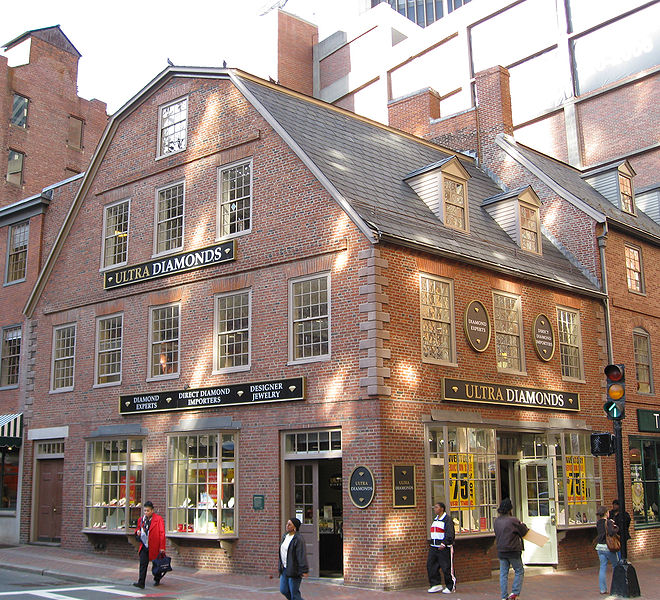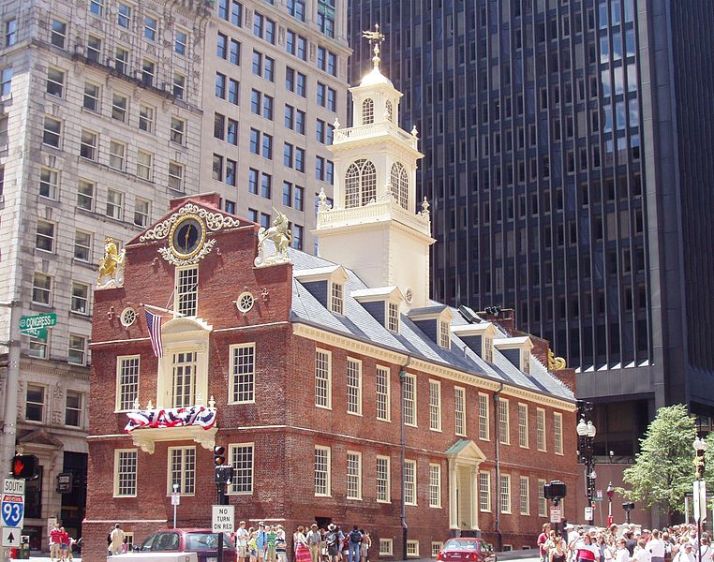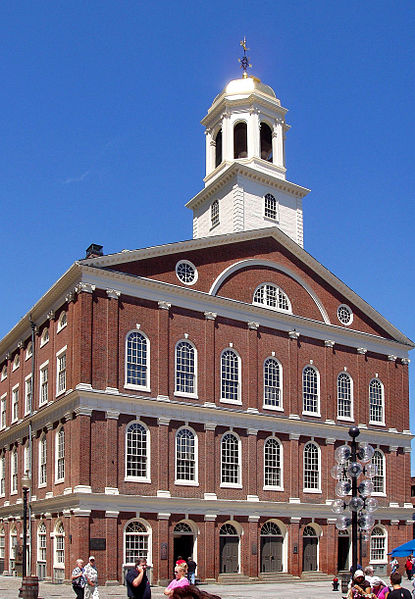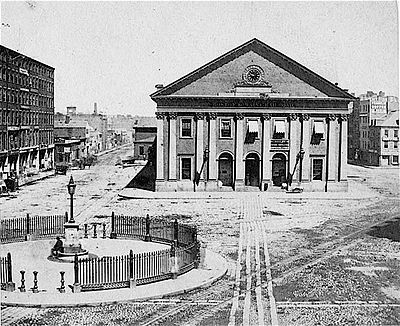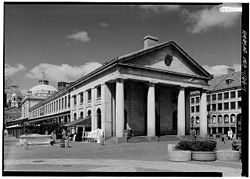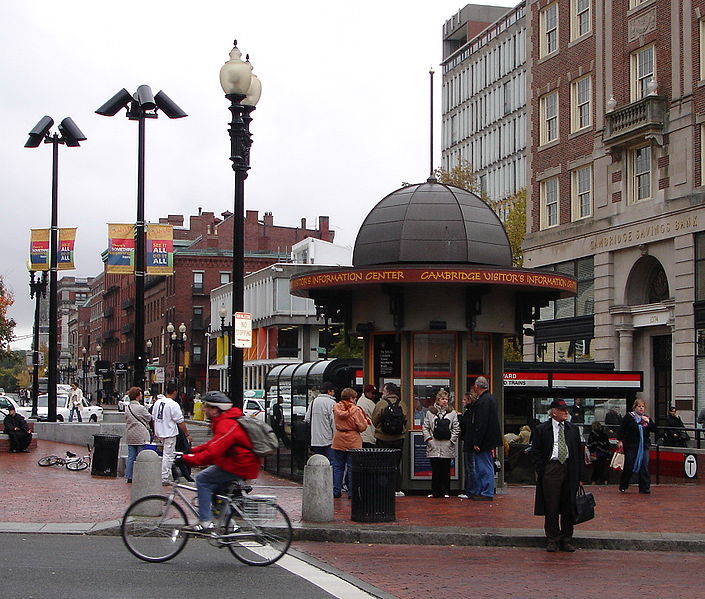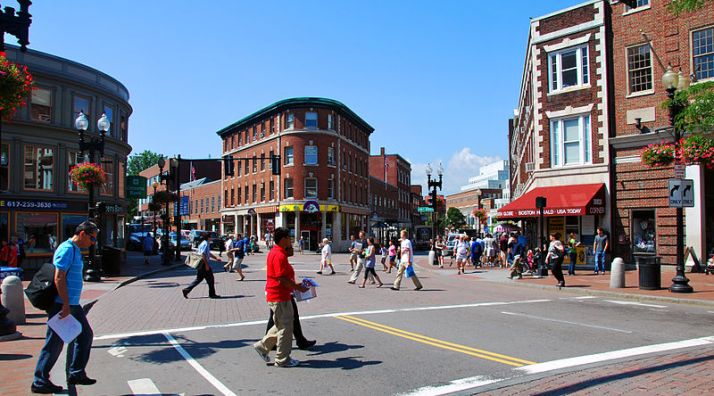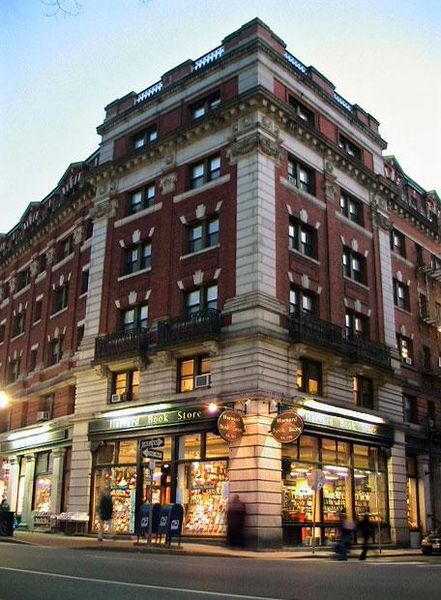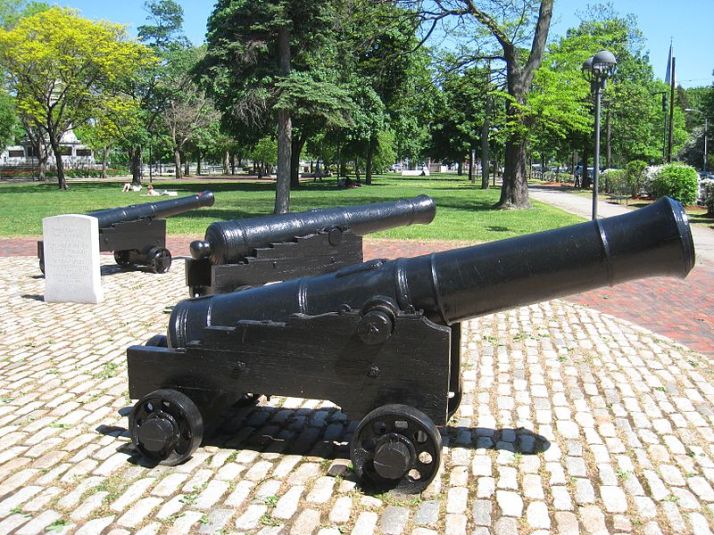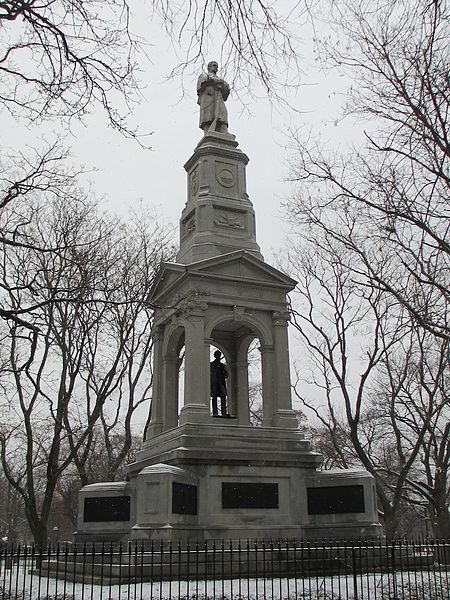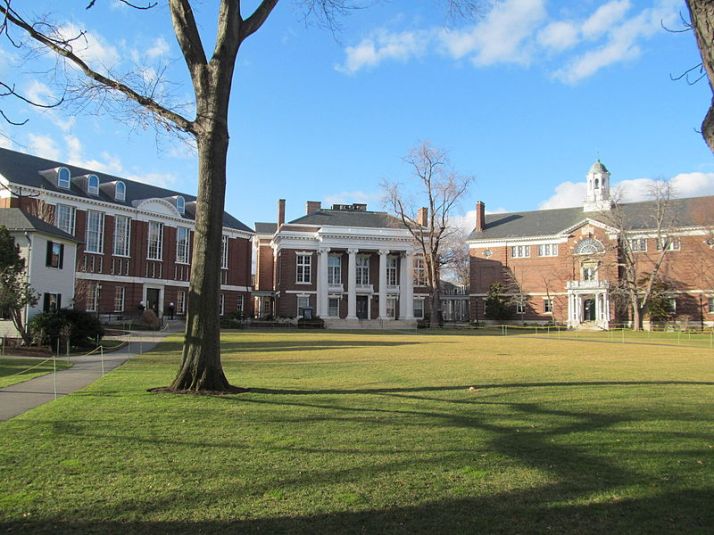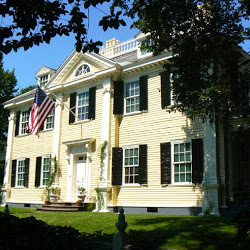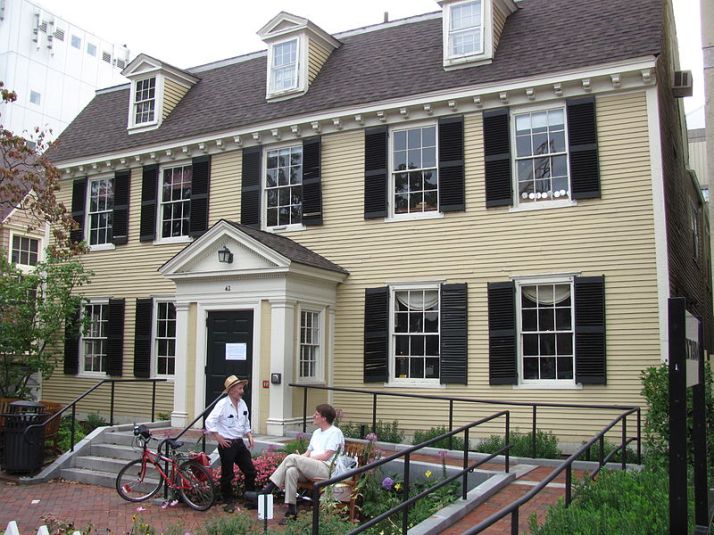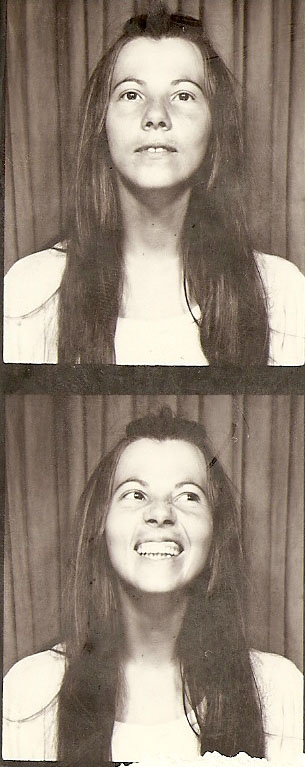For me walking is the greatest way to get to know and love Boston. There are many stories that highlight Boston’s history, architecture and culture especially the Freedom Trail, today I am going from the Boston Common to Faneuil Hall, which reflects the time when Boston was first settled to now, creating quirky streets and mixed architectures expanding almost 400 years. I will learn about important Bostonian events and their work to gain independence from Great Britain, giving me a sense of what has come before my time.
The Freedom Trail is made up of red paint, red granite stone and mostly a red brick path through downtown Boston. I find simple ground markers explaining events, graveyards, notable churches and other buildings along the way. The trail was originally conceived by a local journalist who since 1951 had promoted the idea of a pedestrian trail to link together important local landmarks. In 1953, there were 40,000 people annually walking the path.
I start my walk at 630 Washington Street and on the building is a tablet marking the spot of a famous elm tree bearing the image of a beautiful elm with the inscription “Sons of Liberty, 1766”. At that time this was the neighborhood of the elms. I cross the street and find a small bronze plaque placed in the sidewalk which reads: “Sons of Liberty 1766; Independence of the Country 1776.”
This is where the first public show of defiance against the British Crown was on 8/14/1765 when an American colonist crowd gathered under a large elm tree that stood at the corner of Essex Street and Washington Street, originally called Orange Street a block away from the Boston Common, in the days before the American Revolution and became a rallying point for growing resistance. They were protesting their hatred of the Stamp Act of 1765 in which the British required all legal documents, permits, commercial contracts, newspapers, pamphlets, and playing cards in the colonies to carry a tax stamp. This was perceived by colonists as censorship or a “knowledge tax” on their rights to write and read freely.
The Patriots, later calling themselves the Sons of Liberty, hung an effigy in the branches of the tree, of Andrew Oliver who had been chosen by King George III to impose the tax. Also hung in the tree was a British cavalry jackboot, and inside was a grinning devil-like doll holding a scroll marked “Stamp Act”. This started the resistance that lead to the American Revolutionary War 10 years later at which time a sign stating “Tree of Liberty” was nailed to the trunk of the tree, the tree dates from 1646 to 1775, it lived for 129 years.
In the years leading up to the war the British used the Liberty Tree as an object of ridicule: British soldiers tarred and feathered a man forcing him to march in front of the tree; during the siege of Boston some Loyalists cut the tree down in an act of spite and used it for firewood this enraged the colonists more. As resistance to the British grew a Liberty Tree Flag was flown to symbolize the spirit of liberty and was a common sight during the battles of the revolution. The militia trained here near the tree.
I walk a block into the Boston Common known by the locals as “the Common” which is a central public park, dating back to 1634, making it the oldest city park in the United States. The 50 acres of land is bounded by Tremont Street, Park Street, Beacon Street, Charles Street and Boylston Street. It is part of the Emerald Necklace of parks and parkways that extend from the common south to Franklin Park in Roxbury covering 7 miles by foot which is a great way to get in touch with nature while in the city.
The Common was owned by one of the first European settlers in Boston who sold it to the Puritan founders of the Massachusetts Bay Colony. Park status happened between 1830 and in 1836 it was fully enclosed by an ornamental iron fence. It had five perimeter malls or recreational promenades, the first being Tremont Mall in 1728. In 1913 prehistoric sites were discovered indicating Native American presence in the area as far back as 8,500 years ago.
The Common has been used for a variety of purposes. During the 1630s it was used by many affluent families as a cow pasture, but they overgrazed, so in 1646 the number of cows was limited, then in 1830 cows were formally banned. Before the American Revolution it was used as a camp by the British until they left it for the Battle of Lexington and Concord. It was also used for public hanging until 1817; in 1660 a woman was hung there by Puritans for preaching Quakerism; and in 1656 a woman was executed on charges of witchcraft. Most were hung from a large oak tree which was replaced with gallows in 1769. On 5/19/1713 two hundred citizens rioted in the Common in response to a food shortage, later they attacked the ships and warehouses of a wealthy merchant who was exporting grain for higher profits and the lieutenant governor was shot during the riot.
The common has recently been used for formal and informal gatherings: speeches by famous people like Martin Luther King Jr. and Pope John Paul II; concerts like Judy Garland in 1967; protests in early 1965 when one hundred people gathered to protest the Vietnam War, in 1969 around 100,000 people were protesting that same war; besides softball games, and ice skating on Frog Pond.
As I walk along the Boylston Street side of the Common I come to The Central Burying Ground. Buried here are artists, composers, America’s first poets, Boston Tea party participants, revolutionary war fighters, British soldiers who died during the occupation of the city in 1775-1776 from disease, and the Bunker Hill wounded who died from infection. This is a great cemetery to do tombstone rubbings. I walk along the Common turning left onto Tremont Street.
As I come to the corner of Tremont Street and Park Street my eyes are drawn to the steeple rising up 217 feet which remains a landmark visible from several of Boston’s neighborhoods. The Park Street Church was founded by twenty-six locals, former members of the Old South Meeting House who wanted a church with orthodox Trinitarian theology. It was founded on 2/ 27/1809, the cornerstone was laid on 5/1/1809, construction was completed at year’s end, and the first worship service was on 1/10/1810. It became known as “Brimstone Corner” because of the storage of gunpowder during the War of 1812 and the missionary preaching style.
The Park Street Church is also the former site of the Granary building and adjacent to it is the Granary Burying Ground/Old Granary Cemetery on Tremont Street which was given this name in 1737; before that it was called the South Burying Ground and was needed to meet the city’s growing population. Founded in 1660 it is the city’s third-oldest cemetery. It contains 2,345 gravestones and many unmarked graves thus there could 5,000 people buried here.
I travel back in time to the 1860s and visualize the Egyptian revival iron gate and fence along Tremont Street, I walk under the shaded entrance created by a row of eleven large European elms called Paddock’s Mall”, planted a hundred years ago that now are ten feet in circumference, as I look across the grounds covered with trees planted thirty years ago, I see a small forest in the city. The first thing I come across is the ashes of the American casualties in the Boston Massacre on 3/5/1770. The grave markers were placed in a straight line during the 1800s to conform to nineteenth century style and to make it easier for the groundskeeper. I gravitate to the granite obelisk erected in 1827, which came from the Bunker Hill Monument quarry, and replace the original dilapidated Franklin family gravestones; this is where Benjamin Franklin parents are buried. Near the monument is the oldest memorial for John Wakefield who died in 1667 at the age of 52. I find tombs which are near the back of the property and in 1717 the town enlarged the Burying Ground and in 1720 there were 15 tombs added and assigned to families in the city. I find many famous Revolutionary War patriots, Declaration of Independence signers, Paul Revere and Boston Massacre victims. I wake from my revelry to see what is left of this historic area that tells a story of a time long passed. Another just place for tombstone rubbings.
I continue down to 58 Tremont Street where it crosses School Street and stop outside the historic King’s Chapel Burying Ground. This is the first and oldest cemetery in the city, founded in 1630 and was the only burial site till 1660. Around 1686 King James II appointed royal governor over the colonies of Massachusetts ordered the building of the wooden chapel, to be erected on the old burying ground, over strong objectives from the Puritans. It was located on public burying ground because no resident would sell land for a non-Puritan Church. The original wooden King’s Chapel was built in 1688 and was the first Anglican Church in New England.
I stand in front of the stone building, that was construction around the wooden one starting in 1749 and completed in 1754, and the wooden structure was taken apart and removed through the windows of this building. During the American Revolution it was vacated by the Loyalists who escaped to Canada and was called the “Stone Chapel” and was reopened in 1782 when they returned. The bell was hung in 1772, cast in England; it cracked in 1814, and was recast and re-hung by Paul Revere. It is the largest bell cast by the Revere foundry and the last one by Paul Revere. It is ringing now announcing services.
As I wander inside my eyes are drawn to the wooden columns with Corinthian capitals that were hand carved in 1758. The wooden box pews were originally owned by paying family members who decorated. Today it’s the beautiful wood that stands out in their uniform appearance that dates back to the 1920s. The European organ is decorated with miters and carvings from the Bridge Organ of 1756 and was built in 1964. It is the sixth organ built in the church and the first one was in 1723.
I walk down to 45 School Street and stand in from of the courtyard and my eyes are drawn to the 8 foot bronze statue of Benjamin Franklin. It stands in front of Boston’s elaborate French Empire style building. Near the stature of its most famous dropout is a plaque on the sidewalk in front of Old City Hall, marking the former location of the Boston Latin School. The Boston Latin School was the first public Schoolhouse, the oldest existing School in the United States, founded in 1635, in operation from 1704 to 1748 and on the same street until 1844, and now operates at another location. It educated the sons of the Boston Elite, and its curriculum followed the 18th century Latin School movement where the classics were the basis of an educated mind with the mandatory four years of Latin. It educated American founders like Samuel Adams and John Hancock, and produced four Harvard Presidents, four Massachusetts governors and five signers of the Declaration of Independence. It was an all male school until 1972 when they admitted its first co-educational classes.
On this site of the former Latin School I stand in front of the Old City Hall completed in 1865 and in use till 1969. It symbolizes a cosmopolitan spirit of Victorian Boston, an example of French Second Empire Style with its copper mansard roof, now a faded blue-green. It was one of the first buildings in the French Second Empire style to be built in the United States and after its completion the style was used extensively elsewhere in Boston and the United States and is now one of the remaining few. The first building here was the Suffolk County Courthouse erected in 1810 and converted to Boston’s second city hall in 1841, which was replaced by the current building twenty-four years later. Thirty-eight mayors have served their terms of office at this site over a period of 128 years. In 1969 City Hall moved and this old City Hall was converted to serve other functions, which is an early example of adaptive reuse. It is listed on the National Register of Historic Places and was designated as a U.S. National Historic Landmark in 1970; it now houses a number of businesses, organizations and restaurants.
I proceed down School Street to Washington Street and stop in front of the historic old Corner Bookstore in the center of Boston. The former building burned down in the great Boston Fire of 1711 and was the home of Anne Hutchinson who was expelled from Massachusetts in 1638 for heresy and she went to Rhode Island. A new building, the one I am standing in front of, was constructed in 1712. The upper floors were the living space and the first floor was the apothecary shop for the many generations of pharmacists who used it.
It was first used as a bookstore in 1828; the first floor of the building was renovated with the addition of projecting small-paned windows. In the 19th Century it was one of the most important publishing companies in the United States. From 1832 to 1865 the Old Corner Bookstore became a meeting place for authors: Henry Wadsworth Longfellow, Ralph Waldo Emerson, Nathaniel Hawthorne, Charles Dickens and Oliver Wendell Holmes Sr. Other parts of the building were rented out and sublet to other businesses. It has houses many booksellers and publishing houses throughout its history.
I walk down to 310 Washington Street and stop in front of the Old South Meeting House, a National Historic Landmark, my eyes move up towards the sky following its 183 foot steeple which was completed in 1729. It is situated in the Downtown Crossing area and gained fame as the organizing place for the Boston Tea Party on 12/16/1773 that is when 5,000 colonists gathered in the largest building at the time, debating British taxation then headed for the harbor. After the Boston Massacre there was a yearly anniversary meetings held here until 1775 with speakers like John Hancock. The British occupied the meeting house because it symbolized the Revolutionary cause; they gutted the building, filled it with dirt and used the interior for horse riding practice, trying to destroy it besides stealing many of items they found there.
During the Great Boston Fire of 1872 it was saved by the timely arrival of a Portsmouth, New Hampshire fire engine. For nearly three centuries it has been an important gathering place. It is famous for protest meetings before the American Revolution, and was called a mouth-house as it served as a platform for the free expression of ideas. People continue to gather for discussions and to act on important issues. It is the second oldest establishment in existent in the United States and contains a museum which houses vital heritage, history, and the stories of famous men and women.
I continue walking on Washington Street to where it intersects with State Street and eye the historic Government building called the Old Massachusetts State House. I am fascinated by the gilded unicorn and lion on its gables the symbols of English domination which were removed after the Revolution and later replaced by replicas. In 1657 the first building built here was a wooden Town House with a ground floor open to merchants until it was destroyed by the Great Fire of 1711. Two years later in 1713 the first bricks were laid for the Massachusetts colonial government’s new offices. It is the oldest surviving building in Boston and was the state legislature seat until 1798.
This building occupied the city’s most prominent intersection which is now called State Street and led all the way to Long Wharf, while Washington Street crossed here and use to be the only street connecting Boston to the mainland. The governors would stand on the balcony looking toward Long Warf. People and businesses settled around the building while famous scenes of the Revolution unfolded here. In 1798 the new State house opened on top of Beacon Hill while this building passed on to other uses, presently a museum, and in 1881 was protected by The Bostonian Society.
I cross the street to the sidewalk and in the middle of the square is a cobblestone circle marker where the Boston Massacre took place in front of the Old State House. On 3/5/1770 The Boston Massacre was a street fight, called the Incident on King Street by the British, which took place when British Army soldiers killed five civilian men and injured six others. In 1768 British troops were stationed, to protect and support the crown-appointed colonial officials attempting to enforce unpopular Parliamentary legislature, in Boston the capital of the Province of Massachusetts Bay. There was ongoing tension between the population and the soldiers, a mob of fifty citizens formed around a British sentry, verbally abusing and harassing the soldier who was joined by eight additional soldiers then the crowd got increasingly agitated and threw snowballs, stones and sticks at them. The soldiers without orders fired into the crowd, instantly killing three people and wounding two others who later died from their wounds. The crowd dispersed when the Acting Governor promised an inquiry, which prompted the withdrawal of the troops to a harbor island. Eight soldiers, one officer and four civilians were arrested and charged with murder. The soldiers were defended By John Adams, a future President, six were acquitted while two were convicted of manslaughter and given reduced sentences which was just a branding on their hand. This incident resulted in reports, depictions, a colored engraving by Paul Revere and much propaganda about the event used to increasing the tension throughout the Thirteen Colonies and is viewed as a foreshadowing the outbreak the American Revolutionary War five years later.
I head down State Street towards the waterfront and Government Center to the Marketplace. I love the Faneuil Hall Building which has been a marketplace and meeting hall since 1742. Many speeches encouraging independence from Great Britain were given here by such greats as Samuel Adams and James Otis, so it is sometimes referred to as “the Cradle of Liberty” and is now a part of the Boston National Historic Park and is on the National Register of Historic Places.
The story goes that for many years there were discussions about erecting a public market house in Boston and in 1740 Peter Faneuil offered to build it as a gift to the town. It was built in the style of an English country market with an open ground floor as the market and an assembly room upstairs. There is a grasshopper weather vane on top which is a well known symbol of Boston, knowledge of it was used as a “shibboleth” during the Revolution, suspected spies would be asked to identify the object on top of the hall, if right they were free, if not they were convicted as British spies. The hall was destroyed by fire in 1761 leaving only the brick walls standing so it was rebuilt in 1762. In 1775 when the British occupied Boston they used it for a theater.
In 1805 Faneuil Hall was: doubled in height and width, added a third floor, four new bays were added to the three already there, the open arcades were enclosed, and the cupola was moved to the opposite end of the building, Doric brick pilasters were applied to the lower two floors, Ionic pilasters on the third floor, and galleries were built around the assembly hall. In 1898-1899 it was entirely rebuilt of noncombustible materials.
I walk east and behind the Hall to Historic Quincy Market which was constructed in 1824-1826. The Market is two stories, 535 feet long and covering 27,000 square miles of land. Since Boston had a tendency for territorial growth by landfill, part of the harbor was filled in with dirt to provide the plot of land for the market along with six new city streets. The exterior is largely traditional New England granite, red brick interior walls and is the first large scale granite and glass in post-and-beam construction. The interior has innovative cast iron columns and iron tension rods. The east and west facades have a strong Roman style, strong triangular pediments and Doric columns, where as the sides of the hall are more American modern with rows of rectangular windows. The shape is a long rectangle creating a long hallway down the center. On the roof are eight evenly spaced chimneys with a copper-based dome in the center that covers an open two story common seating area and the major side entrances.
The Market is named in honor of the Mayor who organized its building without any tax or debt. It was built as an indoor pavilion for vendor stalls because in 1822 Boston had incorporated as a city and its commercial demand grew beyond the capacity of Faneuil Hall. The Market was largely used for produce and foodstuff with various grocers selling eggs, cheese and bread lining its inside walls with some butchering work done on site. Outside there were street vendors against its walls and in its plazas, I see some of the old signs hanging in the upstairs seating hall. There are still vendors on the outside walls selling trinkets, gifts and curios and the south side is under a glass with a few restaurants enclosed in it.
The main building has evolved from groceries to food stall, fast food and restaurants. The second floor is conventional retail space while the basement is occupied by bars and restaurants. Flanking the main building in the marketplace are two equally long buildings called the North Market and South Market with more restaurants, specialty shops and offices. Two further concave market buildings enclose a circular plaza at the market’s west end. The open space at both the east and west ends of the marketplace are a common venue for street performers and venders where a large circular crowd of people will gather around to check out what is going on. Well I am going to stop here to shop and eat. I will write you soon describing the rest of my walk on the Freedom trail into the North End and down to the Harbor.
